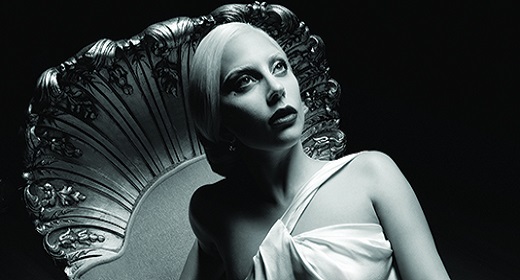by Jake Taylor: The pop diva’s efforts to help young people struggling with depression were inspired by her many loyal fans—and her own brushes with despair and trauma…
With the release of her album The Fame in 2008, the world was introduced to the superstar known as Lady Gaga. Not since the advent of Madonna had the music industry and its global audience met a character so outsized in her independence, individuality, and willingness to provoke.
If the 22-year-old platinum blonde wanted fame, she got it in spades—for better and for worse.
Over the next few years, dance-pop hits like Poker Face, Bad Romance and Born This Way struck a chord with fans around the world. So did the singer’s outrageous onstage outfits, including the infamous raw-meat dress she sported at the 2010 MTV Video Music Awards.
In return, the struggles of her fans—with homophobia, bullying, depression, and the difficult task of figuring out your true self—struck a chord with the singer.
“I often felt lonely and depressed when I was growing up. It had nothing to do with my parents—it’s just my brain chemistry,” says Gaga, who turned 30 this spring.
“As I grew older, I found a way to release myself from those darker thoughts through music. Music was my way of overcoming a lot of pain and anxiety. If you give yourself to your creativity and imagination, it can help you overcome almost anything and really enable you to feel free and powerful.”
Powerful, indeed. Just two years after her debut splash, Time magazine named Lady Gaga one of the 100 most influential people in the world. And she has appeared repeatedly among Forbes magazine’s 100 most powerful women in the world (not to mention the highest-paid celebrities).
To date, her creativity has yielded five studio albums, six Grammy award wins, and a Golden Globe for her role as the exquisitely villainous Countess Elizabeth in American Horror Story: Hotel. Yet separate from the accolades and the income, the megastar often talks about using her art to help others.
Responding to challenges faced by her devoted fans in the gay community, she became an outspoken advocate for ending the U.S. military’s “don’t ask, don’t tell” policy and championed marriage equality.
Her Born This Way Foundation was also directly inspired by her “Little Monsters,” as her legions of fervent followers are known. (That all goes back to a spoken-word piece in which Mother Monster—aka Gaga—gives birth to “a race which bears no prejudice/ No judgment/ But boundless freedom.”)
“The foundation was born from the years I spent watching my fans grow up,” Gaga told Billboard magazine last year. “They would tell me their stories—and many of them were very dark.”
In fundamental ways, she’s right there with them: “I’ve suffered through depression and anxiety my entire life, I still suffer with it every single day,” she explained. “I just want these kids to know that that depth that they feel as human beings is normal.”
Gaga and her mom, Cynthia Germanotta, launched the foundation in 2011. Then came the Born Brave Bus, which took the foundation’s work on the road. The colorfully decorated bus serves as a kind of pop-up center to raise awareness of youth mental health issues, connect individuals with local services, and “inspire bravery and promote self-acceptance among young people.”
Emotional mentors
Gaga has talked about not fitting in during high school, being made fun of, and feeling “like a freak.” Celebrating your inner truth has been a central theme of her music at least since The Fame, which she told MTV was about self-discovery and finding “a sense of inner fame.”
The lyrics of Born This Way proclaim her manifesto:
There’s nothin’ wrong with lovin’ who you are …
So hold your head up,
girl and you’ll go far
Listen to me when I say
I’m beautiful in my way
‘Cause God makes no mistakes
I’m on the right track, baby
I was born this way
There’s an irony in there somewhere, since the megastar has admitted she invented her Lady Gaga persona in part as a way of coping with depression.
Yet the “black dog” isn’t something she left behind with her birth name. In fact, it snarled forward with a vengeance toward the end of 2013. Gaga had cut short a concert tour earlier that year to have hip surgery, but the real wound was her feelings of betrayal and being used for the money she could earn.
Soon she was having trouble sleeping, the world seemed empty, and her vitality was MIA.
“I was angry, cynical, and had this deep sadness like an anchor dragging everywhere I go,” she explained in a Harper’s Bazaar interview a few months afterward. “I just didn’t feel like fighting anymore. I didn’t feel like standing up for myself one more time—to one more person who lied to me.”
At one point, she continued, “I really felt like I was dying—my light completely out. I said to myself, ‘Whatever is left in there, even just one light molecule, you will find it and make it multiply. You have to for you. You have to for your music. You have to for your fans and your family.’ … I’m lucky I found one little glimmer stored away.”
“One little glimmer” is putting it mildly. By the end of 2014, Gaga and veteran jazz singer Tony Bennett had released Cheek to Cheek, an album of jazz standards that went on to win a Grammy. The two still frequently perform together—and in keeping with her company, Gaga’s wardrobe has shifted from glam-rock to glamorous.
(In fact, apart from her glittering, tottering platform shoes, she looked downright sedate in a silky red Gucci pantsuit when she sang the national anthem at the 2016 Super Bowl.)
Gaga has been clear that medication is an important part of her treatment plan. Working with Bennett, however, provided crucial shelter for her flickering inner light. The octogenarian musician was a fellow artist with no ulterior motives. He offered not only warmth, but useful advice.
“Tony is a very wise and sensitive man,” Gaga says. “When we started working on the album, he could see that I was in a bad place, emotionally. I was in such a terrible state that I would start crying while we were recording. Tony told me that I had to learn to control my breathing so that I could still sing even if I was crying.”
Ryan Murphy, director of the immensely popular TV series American Horror Story, has been another emotional mentor. Gaga says Murphy “has become very important in my life … he’s allowed me to be able to find myself again and get past my fears and anxieties. It’s taken me time to get myself back to a healthier place again.”
She’ll be working with Murphy again on the show’s sixth season, slotted to return to FX this fall.
Letting go of the pain
Although joining the cast of American Horror Story may seem as much of a right-turn for the pop diva as her collaboration with Bennett, it actually reflects a shift from her elaborate constructed identity to one more in keeping with the woman at its core.
Young Stephanie started playing piano at age 4 and later received classical training. She also spent 10 years taking acting lessons at the famed Lee Strasberg Theatre and Film Institute, was a regular in high school productions, and even won a blink-and-you-miss-it role on a Sopranos episode when she was 15.
The manipulative, selfish Countess Elizabeth was a stretch for the performer. In real life, Gaga claims, she’s kind, compassionate, funny, always ready to joke around with friends. Immersing herself in the character’s indifference and meanness wasn’t always easy—and it wasn’t easy to get out of character, either, which she says took a toll on her former fiancé, actor and model Taylor Kinney of Chicago Fire.
On the other hand, “I understand her loneliness and sense of isolation,” Gaga says of the centuries-old blood-drinking aristocrat. Digging into her own girlhood memories helped her connect with that aspect of the character.
Gaga revisited an especially painful aspect of her past in the song Til It Happens to You, written for the documentary The Hunting Ground. The song was a 2015 Oscar nominee in the best original song category and has become an anthem for sexual assault survivors.
After years of denial and silence, Gaga had worked to address feelings of self-blame, shame and damage in therapy. Still, raw emotions resurfaced while crafting the track with veteran songwriter Diane Warren.
The payoff: Shaking off her solitary anguish and finding strength in numbers. And as is the Gaga way, she’s doing what she can to spread that sense of liberation.
“I’m here because … I see a lot of people who have secrets that are killing them,” she said during a panel discussion for the TimesTalks video series.
“We don’t want you to keep your pain inside and let it rot like an old apple on your counter, you know? It’s like, just get rid of all that trash. Let’s get rid of it together.”
The next stage
The power to promote positive change is one upside to being Mother Monster. What’s not so fun: Getting others to see the girl behind the Gaga.
The former Stefani Joanne Angelina Germanotta wants the people in her life “to love the real me, not the idea of me that they think they know [from the media]. This has probably been one of my biggest struggles as a human being,” she muses.
She felt “happier than ever” working on American Horror Story with the likes of Kathy Bates and Angela Bassett—people who know a little something about celebrity—because the other cast members were “so kind and generous and accepting of me.”
Perhaps Gaga preaches so passionately about self-acceptance because it’s something that’s been hard for her to come by.
“I invented myself, Lady Gaga—I curated my life to be an expression of my pain,” she explained in remarks at the Yale Centre for Emotional Intelligence last October. “This is how I overcame my depression, by creating someone that I felt was stronger than me. But nothing was able to fix how I was genetically made.
“No matter how much success you have, no matter how many people accept you to your face, the person that really needs to accept you is you.”
So has the Gaga/Germanotta split healed? No longer content just to stay in the protective shadow created by her larger-than-life persona, this mutable performer may be ready for the most stunning transformation yet.
“People always expect me or want me to be wild,” she says. “But now I just want to be a normal girl!”
*****
Lady Gaga at a glance
The entertainment phenomenon known as Lady Gaga entered the world on March 28, 1986 as Stefani Joanne Angelina Germanotta. Raised on Manhattan’s Upper West Side, she reportedly began playing the piano at age 4 and was performing at open-mike nights by 14.
As a student at the exclusive Convent of the Sacred Heart, she was (in her own words) “very dedicated, very studious, very disciplined.” Her expansive spirit took wing at New York University’s Tisch School of the Arts. At 19, she left and immersed herself in the music and performance art scene on the Lower East Side for the next few years, developing the Lady Gaga persona.
And thus a megastar is born:
2008: She relocates to Los Angeles and releases her first album, The Fame, a worldwide hit which produced the chart-topping singles Paparazzi, Just Dance and Poker Face.
2009: After her first global concert tour, she releases The Fame Monster, an equally successful follow-up dealing with the darker side of fame. The extended-play album spawns singles Bad Romance, Telephone and Alejandro. She launches the glamtastic Monster Ball Tour in November, which keeps her busy for the next year and a half.
2010: After just two years in the pop-music industry, Gaga appears on Time magazine’s list of the most influential people in the world and debuts on Forbes magazine’s 100 most powerful women.
2011: Her second full-length album, Born This Way, tops the charts in more than 20 countries—including the United States, where it sold over one million copies in its first week.
2012: Born This Way Ball and Born Brave Bus tour begins in April 2012 but gets cut short in February 2013 when Gaga injures her hip and requires surgery.
2013: Critics didn’t love her album Artpop, but fans embraced singles Applause and Do What U Want, featuring R&B singer R. Kelly. A deep depressive episode has her thinking about quitting the music biz.
2014: Gaga shifts gears with Cheek to Cheek, a collaboration with Tony Bennett featuring jazz standards like Anything Goes and Sophisticated Lady. Like her two previous albums, it goes to number one in the U.S. and breaks the top 10 in more than two dozen countries around the globe.
2015: In the music sphere, Gaga is Billboard’s Woman of the Year. In another major shift, however, she takes on the role of hotel owner Countess Elizabeth in American Horror Story: Hotel—earning her a 2016 Golden Globe Award. (She’s tapped for the show’s sixth season, which will return to FX this fall.)

















































